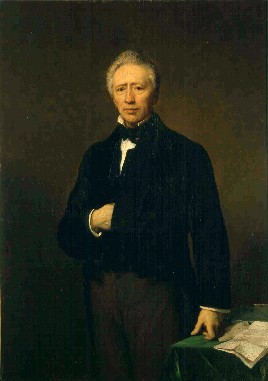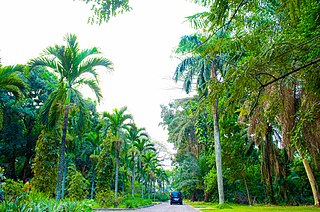
Barthélemy Charles Joseph Dumortier was a Belgian who conducted a parallel career of botanist and Member of Parliament.

Brussels Park is the largest urban public park in central Brussels, Belgium. Formerly known and still sometimes colloquially referred to as the Royal Park, it was the city's first public park, being originally laid out between 1776 and 1783 in a neoclassical style by the French architect Gilles-Barnabé Guimard and the Austrian landscape architect Joachim Zinner, as part of an urban project including the Place Royale/Koningsplein. The area of the rectangular park is 13.1 ha.

The Royal Museum for Central Africa (RMCA), communicating under the name AfricaMuseum since 2018, is an ethnography and natural history museum situated in Tervuren in Flemish Brabant, Belgium, just outside Brussels. It was originally built to showcase King Leopold II's Congo Free State in the International Exposition of 1897.

The Meise Botanic Garden, until 2014 called the National Botanic Garden of Belgium, is a botanical garden located in the grounds of Bouchout Castle in Meise, Flemish Brabant, just north of Brussels. It is one of the world's largest botanical gardens, with an extensive collection of living plants and a herbarium of about 4 million specimens. The current garden was established in 1958 after moving from central Brussels; the former site is now the Botanical Garden of Brussels.

On January 1, 2023, the cantonal botanical gardens and museum merged to become a department of the Naturéum, Switzerland's natural science museum located in Lausanne, Vaud. The botanical department includes the museum and botanical garden in Lausanne, as well as the botanical garden, La Thomasia, in the Alps near the town of Bex. Administered under the Service of cultural affairs of Vaud, the botanic department engage in the study and protection of local flora, as well as in promoting public awareness in biodiversity and nature education in general.

The Centre for Fine Arts is a multi-purpose cultural venue in the Royal Quarter of Brussels, Belgium. It is often referred to as BOZAR in French or by its initials PSK in Dutch. This multidisciplinary space was designed to bring together a wide range of artistic events, whether music, visual arts, theatre, dance, literature, cinema or architecture.

The Royal Greenhouses of Laeken are a vast complex of monumental heated greenhouses in the park of the Royal Palace of Laeken, Belgium. The historic complex contains tropical, subtropical and cold greenhouses, and is home to the famous Royal Botanic Collection, which includes large collections of camellias, orange trees and many plants originating from the African parts of the former Belgian Empire.

François Crépin was an important botanist of the 19th century and director of the National Botanic Garden of Belgium.

Botanique (French) or Kruidtuin (Dutch) is a Brussels Metro station on the northern segment of lines 2 and 6. It is located under the Small Ring at the Rue Royale/Koningsstraat in the municipality of the Saint-Josse-ten-Noode, north of the City of Brussels, Belgium. It opened as a premetro station on 18 August 1974 and became a full metro station on 2 October 1988.
Henri Guillaume Galeotti was a French-Belgian botanist and geologist of Italian parentage born in Paris. He specialized in the study of the family Cactaceae.

The Jardin Botanique de l'Université de Strasbourg, also known as the Jardin botanique de Strasbourg and the Jardin botanique de l'Université Louis Pasteur, is a botanical garden and arboretum located at 28 rue Goethe, Strasbourg, Bas-Rhin, Alsace, France. It is open daily without charge.

The jardin des plantes de Montpellier is a historic botanical garden and arboretum located on Boulevard Henri IV, Montpellier, Hérault, Occitania, France. It is maintained by the Université Montpellier 1 and open afternoons daily except Monday; admission is free.

The Rue Royale or Koningsstraat is a street in Brussels, Belgium, running through the municipalities of Schaerbeek, Saint-Josse-ten-Noode and the City of Brussels. It is limited to the south by the Place Royale/Koningsplein in the city centre and to the north by the Place de la Reine/Koninginplein in Schaerbeek.

The Botanical Garden of Brussels is a former botanical garden in Brussels, Belgium. It was created in 1826 and stood on the Rue Royale/Koningsstraat in Saint-Josse-ten-Noode, near Brussels' Northern Quarter financial district, until its relocation in 1938 to the National Botanic Garden of Belgium in Meise, Flemish Brabant.

The Conservatory and Botanical Garden of the city of Geneva is a museum and an institution of the City of Geneva.

The Cirque Royal (French) or Koninklijk Circus (Dutch), meaning "Royal Circus", is an entertainment venue in Brussels, Belgium. Conceived by the architect Wilhelm Kuhnen in 1953, the building has a circular appearance, but in fact is constructed as a regular polygon. It can hold 2,000 spectators, and nowadays is primarily used for live music shows.

The Flagey Building also known as the Radio House is a building located in Ixelles, a municipality of Brussels, Belgium, housing the Flagey cultural centre. It is located on the south-western corner of Place Eugène Flagey/Eugène Flageyplein, with its main entrance on the Place Sainte-Croix/Heilig-Kruisplein.

The Central Boulevards are a series of grand boulevards in central Brussels, Belgium. They were constructed following the covering of the river Senne (1867–1871), as part of the major urban works by the architect Léon Suys under the tenure of the city's then-mayor, Jules Anspach. They are from south to north and from west to east: the Boulevard Maurice Lemonnier/Maurice Lemonnierlaan, the Boulevard Anspach/Anspachlaan, the Boulevard Adolphe Max/Adolphe Maxlaan, and the Boulevard Émile Jacqmain/Émile Jacqmainlaan.

Les Orangeries of Bierbais is located in Hévillers, a section of the municipality of Mont-Saint-Guibert, located in the Wallonia in the province of Walloon Brabant in Belgium.

The Kinshasa Botanical Garden, formerly known as the Fernand De Boeck Park is a botanical garden located in Gombe, Kinshasa, in the western part of the Democratic Republic of the Congo (DRC). Covering seven hectares, It is strategically positioned opposite the Kinshasa Zoological Garden on Kasa-Vubu Avenue. The botanical garden houses a diverse collection of 286 plant species, including nurseries, a seed collection, an arboretum of native species, and a herbarium. Established in 1933, It is managed by the Congolese Institute for the Conservation of Nature and serves as a hub for environmental education activities, boasting over 100 arboreal species.























